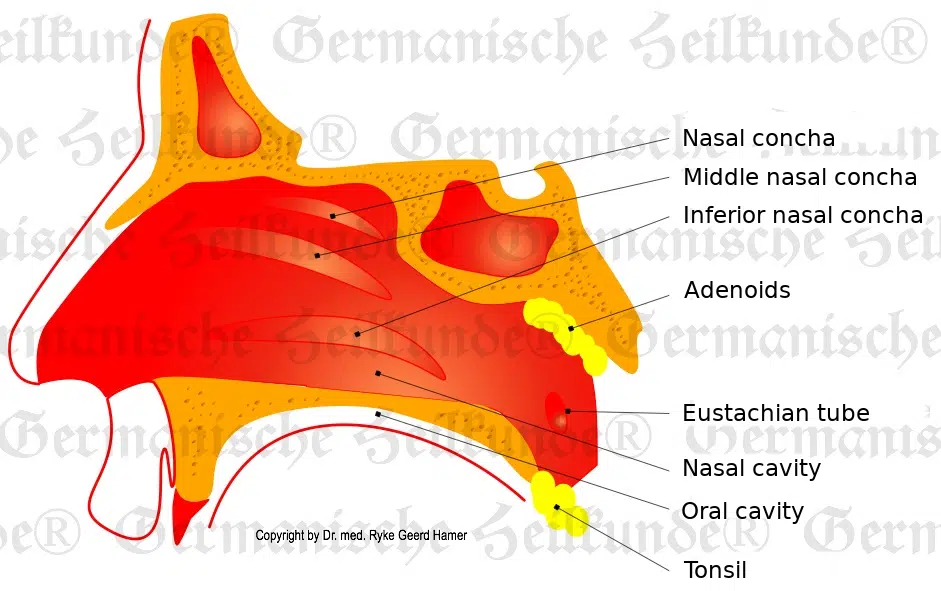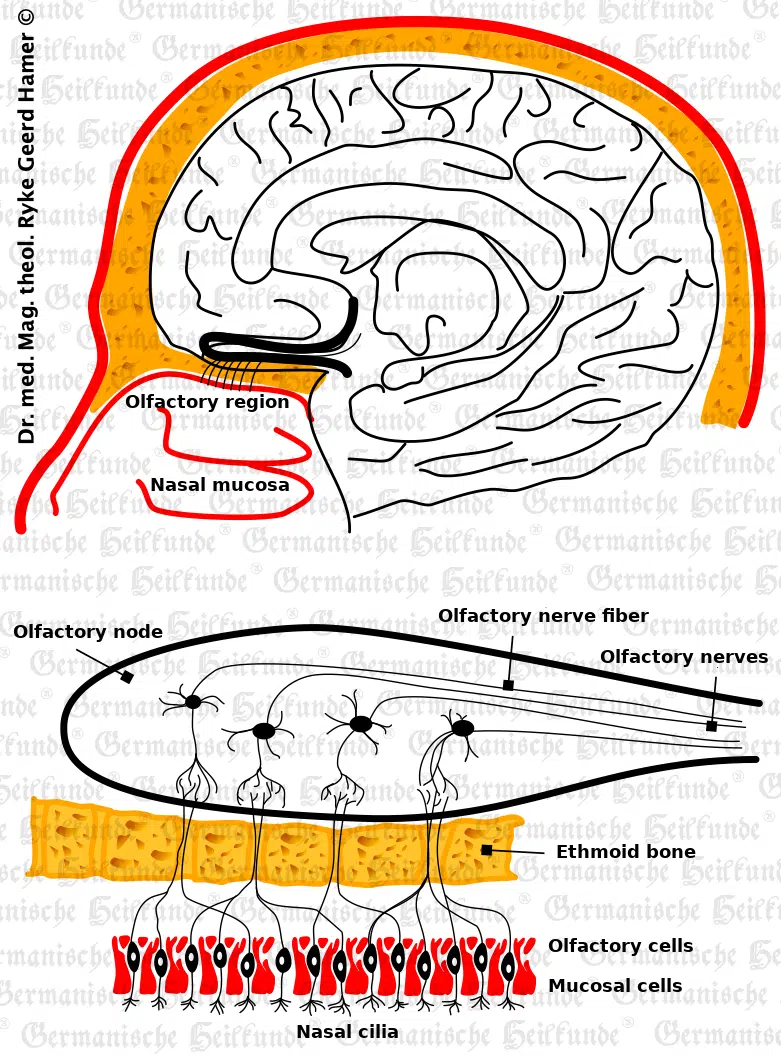Germanische Heilkunde® is a natural science, like physics, chemistry, or biology. It requires precise diagnostic work, far more than the conventional symptom medicine. This is because healing diagnostics occur on three levels: in the psyche, the brain, and the organ. These three levels always run synchronously.
Every so-called disease, i.e., Special Program of Nature (SBS), is triggered by a DHS (Dirk Hamer Syndrome). i.e., a particular, Biological Conflict Shock. The DHS causes a Hamer Focus at the exact second that it is triggered, and this Hamer Focus can be detected in the brain-computed tomogram, in the brain relay responsible for the organ and causes corresponding changes, tumours or paralysis, or functional changes, etc. in the organ. In GHK this is known as The First Biological Law or The Iron Rule of Cancer (IRC).
This means that since the DHS occurs at the same time in the psyche, in the brain, and on the corresponding organ, in GHK we refer to biological conflicts rather than to psychological conflicts. Humans, animals, and even plants can suffer from biological conflicts.
The DHS is the linchpin of the entire scope of Germanische Heilkunde®. Therefore, it is essential that we realise that at the moment of the DHS, which unexpectedly hits the human being “on the wrong foot,” or off-guard, is not only a distressing shock experience, but a conflict experience shock which has a particular content!
The nose, as our olfactory organ, is one of the most sensitive organs.
It combines the functions of the respiratory tract, meaning it filters, warms, cleans, moisturises, and protects the deeper airways. Passages and holes connect the nose with four sinuses, which are paired and symmetrical: Frontal, Maxillary, Ethmoid, and Sphenoid. The nose extends to the ethmoid bone labyrinth, the so-called I. Cranial nerve (olfactory), filaments are distributed over the middle and upper part of the nasal mucosa. They flow directly into the olfactory cusp of the basal cerebral cortex (outer germ layer).
Thus, we find the typical cerebral squamous epithelium, which is also found in the nasopharynx mucosa. All squamous epithelial membranes and mucous membranes develop ulcers, i.e., tissue atrophy, in the conflict-active phase. In the conflict-resolved phase (healing phase), this tissue atrophy, this ulcer, is rebuilt with new cells, which goes on under a substantial swelling. In the past, we did not know this and thought that these new cells, which are supposed to fill up the ulcer again, were sometimes very malignant tumours.
The nasal mucosal ulcer, for example, always has something to do with the inside of the nose. In terms of conflict it corresponds to a so-called scent conflict.

Example: American researchers injected a formaldehyde solution into the nose of rats, the most sensitive organ in a rat. This solution is used for disinfection, and most animals usually give it a wide berth, however in this experiment researchers injected a thousandfold concentration into their noses several times a day for one year! Some of the poor, tortured animals suffered from DHS during this procedure and developed a so-called cancer of the nasal mucosa. Conclusion: Formaldehyde is carcinogenic – thus makes cancer!
There is an extremely high probability that every human being would also have suffered a nasal ulcer with the same experimental arrangement using any concentrated scent solution. The healing of these ulcers was then proclaimed as a carcinoma by conventional medicine! However, it must be remembered that animals have a psyche like humans which means that animal experiments are nonsensical and a crime because the results cannot be transferred to humans.
The Hamer Focus for this organ is located in the cerebral cortex, deep basally.
In the conflict-active phase, ulcers form in the nasal mucosa, but they do not bleed, only “crust.” The longer the conflict lasts, the larger and deeper the ulcer.
In the pcl-phase (healing phase), the ulcers are replenished with new cells, accompanied by severe swelling of the mucous membrane, which we call rhinitis or “allergic rhinitis.” Occasionally, bleeding may also occur. As always, with squamous epithelium, we have the absence and have to sneeze in the crisis.
The sinus mucosa also makes ulcers in the conflict-active phase. This is also based on a stink conflict: “The whole thing stinks to me” – also in a figurative sense. The Hamer Focus is also located fronto-basally. In the conflict-active phase, ulcers develop in the paranasal sinuses, which cause practically no discomfort. Only in the healing phase, after resolving the conflict, the mucosa in the ulcer’s area swells strongly with the secretion of serous fluid (runny nose). At the end of the healing phase, the ulcers are replenished with new cells and healed.
Purulent rhinitis occurs when intestinal (internal) bacterial mucosal components are involved, which are also occasionally found in the paranasal sinuses.
The so-called scent conflicts are one of the most common conflicts or recurrences that we suffer in the course of our lives. However, each conflict recurrence does not come insidiously, but only with a new DHS. We also call it “track.”
Tracks are additional aspects of conflicts or additional perceptions at the moment of the DHS. If the patient later comes to such a track, then a recurrence of the overall conflict may result. Of course, the relapse DHS that puts us back on the conflict track requires nowhere near the emotional strength it did the first time. You could also call it a “powerful reminder.” Often there are even several tracks, and they are not bad, nor permanent mishaps of nature. Generally for an animal in the wild it is a vital memory refresher: “Be careful, last time that happened we got caught off guard and experienced a DHS, be careful not to fall in the same trap.”
We also call such tracks allergies.
In Germanische Heilkunde®, we have learned to appreciate the tracks or allergies even more since we know the 5th Biological Law of Nature. These tracks, which can sometimes disturb, annoy or even hinder us, and we therefore ignorantly believed we have to “treat” them. In the conventional medicine we treat or fight these tracks or allergies whereas in GHK they are, in principle, sensible biological warning signals.
For example, hay fever is an inflammation of the nasal mucosa, triggered allergically (by track). Hay fever was the most common allergy in the past, however this is no longer the case. In earlier times, the first love between two young people often took place in the hay. When this encounter was disturbed or inharmonious, a DHS often occurred. The partner who had the DHS later involuntarily remembers, without making the connections, the catastrophe in the hay as soon as he smells hay again (the allergens and also photoristically, e.g., on TV). The healing phase has swelling of the sinuses, the so-called hay fever. The situation connected with the hay had “stunk” to the patient.
While the cerebrum-controlled organs make cell reduction in the conflict-active phase, the old-brain-controlled organs make cell proliferation in the conflict-active phase. This includes the adenoid tissue of the posterior pharynx, located in the brainstem (inner germ layer).
In the ca-phase, a cauliflower-like growing adeno-Ca develops with secretory qualities, i.e., so-called “polyps” of the nasopharynx, originating from the remnants of the old intestinal mucosa. The conflict includes (left side): “not getting rid of a morsel” or (right side): “not getting hold of a morsel.” They usually arise as pedunculated, sulcid growths in the upper pharynx and grow down to the nose.
In the healing phase, there is usually a fetid cassation of the polyps by fungi (mycoses) or fungal bacteria (mycobacteria) = polyp TB, but only if these microbes were already present at DHS.

The reduction in the ability to smell is a so-called cancer equivalent (outer germ layer), i.e., cessation or reduction of function, but without cell fusion or cell proliferation. This involves a conflict of not wanting to smell something “this smell or stench is repugnant to me,” “…this can’t be true.” Simultaneously, the fila olfactoria, which is a part of the brain, does not change macroscopically. They reduce “only” with the duration of the conflict concerning the perception of a particular smell (anosmia). This is also the biological sense, which is here in the ca-phase, i.e., the unbearable smell is simply “turned off,” faded out.
In the healing phase – similar to a hearing loss – the patients suffer an olfactory overload, i.e., they can no longer smell anything on the affected side (right or left). In this phase, edema and glia are deposited in the fila olfactoria. As a result, a constriction, a blockage, occurs. After completion of the healing phase, however, the ability to smell returns for the most part.
Copyright Dr. Hamer
Translated: John Holledauer
TODAY: 5
LAST 30 DAYS: 3.892
THIS YEAR: 32.412
TOTAL: 151.527
| Cookie | Duration | Description |
|---|---|---|
| cookielawinfo-checkbox-analytics | 11 months | This cookie is set by GDPR Cookie Consent plugin. The cookie is used to store the user consent for the cookies in the category "Analytics". |
| cookielawinfo-checkbox-functional | 11 months | The cookie is set by GDPR cookie consent to record the user consent for the cookies in the category "Functional". |
| cookielawinfo-checkbox-necessary | 11 months | This cookie is set by GDPR Cookie Consent plugin. The cookies is used to store the user consent for the cookies in the category "Necessary". |
| cookielawinfo-checkbox-others | 11 months | This cookie is set by GDPR Cookie Consent plugin. The cookie is used to store the user consent for the cookies in the category "Other. |
| cookielawinfo-checkbox-performance | 11 months | This cookie is set by GDPR Cookie Consent plugin. The cookie is used to store the user consent for the cookies in the category "Performance". |
| viewed_cookie_policy | 11 months | The cookie is set by the GDPR Cookie Consent plugin and is used to store whether or not user has consented to the use of cookies. It does not store any personal data. |
You’ll be informed by email when we post new articles and novelties. In every email there is a link to modify or cancel your subscription.